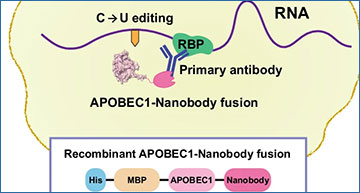
RNA-binding proteins (RBPs) are like the conductors of a biological orchestra, playing a crucial role in how RNA molecules are processed and function within cells. These proteins interact with RNA to regulate its various tasks, such as translating genetic information into proteins, controlling gene expression, and more. Understanding how RBPs interact with RNA is key to unraveling many biological processes and diseases. However, studying these interactions in their natural environment (inside the cell) has been a challenging task.
The Challenge in Studying RBP-RNA Interactions
Traditional methods for studying RBP-RNA interactions often struggle to capture these interactions in their natural settings, like within living cells or tissues. These methods may require large amounts of biological material, which isn’t always available, especially in cases involving delicate tissues like those from clinical samples. Additionally, current techniques may not provide the specificity needed to pinpoint exactly where an RBP binds to RNA within the complex environment of a cell.
Introducing INSCRIBE: A New Method to Study RBP-RNA Interactions
To overcome these challenges, researchers at the University of California, San Diego have developed a new method called INSCRIBE (IN situ Sensitive Capture of RNA-protein Interactions in Biological Environments). This innovative technique allows scientists to study RBP-RNA interactions directly within their natural environment, preserving the biological context that is often lost in other methods.
Schematics of in situ RNA C-to-U editingmediated by recombinant APOBEC1-Nanobody (APO1-Nb)
a Experimental procedure of INSCRIBE. After cell or tissue fixation, the RBP-targeting antibody (Ab) and the APO1-Nb are incubated sequentially, followed by RNA editing in situ at 37 °C overnight. RNAs are harvested for RNA-seq library. Created with BioRender.com released under a Creative Commons Attribution-NonCommercial-NoDerivs 4.0 International license. b Workflow describing data analysis for INSCRIBE. The RNA sequences are aligned to the transcriptome, followed by C-to-U edit quantification by SAILOR and edit clusters identification by FLARE. Subsequently, confident edit clusters are determined by intersecting clusters from three replicates and subtracting the Buffer-only control clusters. UTR: untranslated region.
How INSCRIBE Works
INSCRIBE uses a clever approach to target and label specific RBPs within cells or tissues. The method involves a specially designed tool—a fusion of a protein called APOBEC1 with a nanobody (a small antibody fragment). This fusion protein is precisely directed to the RBP of interest. Once it finds its target, INSCRIBE labels the RNA bound to the RBP, allowing researchers to capture and study these interactions with high specificity.
One of the remarkable features of INSCRIBE is its ability to work with a wide variety of biological samples, including human cell lines (like HEK293T cells) and mouse brain tissue. The method is sensitive enough to detect RBP-RNA interactions in extremely small samples, equivalent to just about five cells. This makes it especially valuable for studying precious or limited biological materials, such as clinical tissue samples.
What INSCRIBE Reveals
Using INSCRIBE, the researchers have successfully identified the exact binding sites of specific RBPs, such as RBFOX2 and TDP-43, within cells. These proteins are known to bind to particular RNA sequences, or motifs, like UGCAUG for RBFOX2 and UGUGUG for TDP-43. INSCRIBE accurately detected these motifs in their natural cellular environment, demonstrating its precision and effectiveness.
Why is INSCRIBE Important
The development of INSCRIBE is a significant advancement in the field of molecular biology. By enabling the sensitive and specific capture of RBP-RNA interactions in their native context, this method opens up new possibilities for studying RNA-related diseases. For example, many neurodegenerative diseases, like ALS (Amyotrophic Lateral Sclerosis), are linked to malfunctions in RBPs like TDP-43. With INSCRIBE, researchers can explore these interactions in greater detail, potentially leading to new insights and therapeutic targets.
INSCRIBE represents a powerful tool for scientists to study the intricate dance between RBPs and RNA within cells. Its ability to work with tiny amounts of biological material, while maintaining high specificity and sensitivity, makes it an invaluable asset in the ongoing quest to understand and treat RNA-related diseases.
